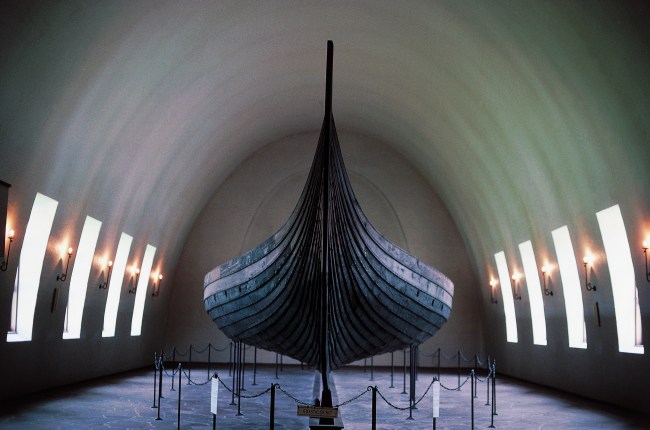
Getty Image / DeAgostini/Getty Images
The photo is of a Gokstad viking ship, not the ship that was found by radar.
A high-resolution radar discovered a 1,000-year-old Viking ship at a “high-status” burial site in Norway. Ground-penetrating georadar revealed a Viking ship beneath the topsoil of a farm near the town of Edøy in western Norway, only five feet below the surface.
Archaeologists from the Norwegian Institute for Cultural Heritage Research (NIKU) made the exciting discovery and published its findings on Tuesday in the Antiquity journal.
The ship and burial ground are believed to from the Merovingian or Viking Period. “The Merovingian Period is a transition phase between the Migration Period and the Viking Age,” according to Avaldsnes. “The Merovingian Period is usually said to belong to the Early Iron Age, while the Later Iron Age begins with the Merovingian Period and continues on into the Viking Age.” The Merovingian Period was from the 5th century to the 7th century.
The radar detected a “high-status” Viking burial site, where Norwegian archaeologists believe there was a feast hall, cult house, farmhouse, and the ship. There are 13 circular burial mounds, some as large as 98 feet. Historians believe this cemetery and settlement was for the elite members of society of its time.
The site of a #Viking ship burial that was discovered two years ago has turned out to be the location of so much more. Thanks to high-tech radar #Norwegian archaeologists have discovered it was a Nordic center of power.https://t.co/o95N1v5GDl pic.twitter.com/iWuoTuz3SS
— Ancient Origins (@ancientorigins) November 11, 2020
The 55-foot-long burial ship would have held the body of a notable Norse leader along with weapons and anything else they would need in the afterlife. The ship, which was found through GPR-scanning technology, has suffered damage after a thousand years of plowing on the surface, but most of the hull appears to be intact.
But why was the boat buried in the ground and not out at sea? Lead study author Lars Gustavsen, an archaeologist with the Norwegian Institute for Cultural Heritage Research, responded by saying, “We do not really know for certain. Since these were societies whose identity was closely tied to the sea and seafaring, the ship could, in this specific context, be seen as a vessel transporting the dead from the realm of the living to the realm of the dead.”
“Or it could simply be a display of wealth, or to demonstrate that one belonged to a certain social and political class,” Gustavsen explained. “We can probably say that it was important for the elite to exhibit their status through lavish and carefully planned burial rituals.”
“We believe that the inclusion of a ship burial in what was probably an already existing — and long-lived — mound cemetery was an effort to associate oneself with an already existing power structure,” he told Live Science.
“We knew that there was something special there, but we had no idea that there was going to be a ship burial, that’s pretty unique,” Gustavsen told CNN.